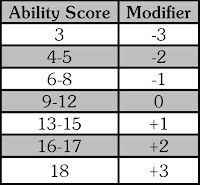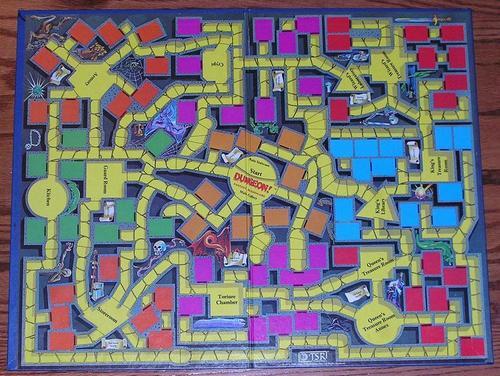I have now done so many posts about experience and advancement, that I have have decided to tag them that way for easy reference. In this case, I am considering tying XP awards directly into dungeon-exploration. A little back-ground first:
4. Characters level up whenever they successfully complete a new level. So, venturing from the 1st dungeon level to the next, if they don't get eaten by the first monster, they level up.
That was flippant and off-hand, but I now think that there is some real meat to this idea. The key is not to focus on getting to the next level, but on exploring the current level.
The Basic Concept: characters earn XP for exploring dungeons.
When I put it that way, I can't believe that I never thought of it before. I mean, that is what the game is supposed to be about, isn't it? The traditional "XP for gold" method is supposed to encourage this (again, I totally misunderstood this for years until Mike Mornard made sense of it for me). And it's not a bad method at all. But it is a little circuitous. And it does have the side-effect of creating of Wiemar Republic-style inflation when a guy has to scrape together 200,000 pieces of gold to make next level. So let's cut out the middle-man and proclaim the following three ideas:
A) The reward for finding treasure is that you have found treasure.
B) The reward for killing monsters is that they cannot eat your spleen.
C) The reward for encountering a keyed area of the dungeon is experience points.
This gives us three distinct rewards which all make sense of the game's premise. You A) collect treasure so that you can hire sell-swords or buy new armour, which allows you to B)kill monsters, who will otherwise eat your spleen and, in sundry other ways, prevent you from C)exploring the dungeon.
Question: What does "exploring" mean exactly?
Answer: It means that the characters have come to understand some portion of the dungeon and can find their way there and back again. That's right: it means mapping. It means no XP if you run away from a spleen-eating monster and get lost. No XP if you are so bad with directions that even you can't figure out where your map leads.
Question: Why "keyed areas" only?
Answer: Insightful question. A classically-designed dungeon is mostly empty. Both the LBB's and Moldvay recommend that only about a third of the rooms have anything worth noting. It seems to me that this makes the keyed areas the ones to find. Yes, you could argue that any rooms should count if the goal is exploration and that's reasonable too, but that gets a bit unwieldy.
Question: Why would that get unwieldy?
Answer: All right, all right; hang on. I haven't gotten there yet. Hang on.
Question: Fine. Then try this: how much experience is a dungeon level worth?
Answer: Now we're back in sync. Let me answer that in bold:
A standard dungeon-level is worth enough experience that a single-class character can advance to the next level upon completion of the exploration.
Traditionally, the Magic-User has the highest XP requirements of any single-classed character; Elves don't count here. An MU needs 2,500 XP to go from Level 1 to Level 2. Therefore, Dungeon Level 1 should give 2,500 XP in total, enough to bring everybody except the poncy Elf to 2nd Level.
And here's where we get to the unwieldy thing from before. It definitely doesn't work to do all that as a lump-sum; the XP has to be parceled out. I first thought about giving XP for each square or hex encountered, but quickly realized that this would become the boring bean-counting exercise I wanted to avoid in the first place. So, instead, we divide that total XP award by the number of keyed areas. If there are 10 keyed areas on the 1st level dungeon, then each area is worth 250 XP. Simple, eh?
Question: Well, maybe, but what if there is a fractional result?
Answer: Then your dungeon is smaller than standard-sized and not worth as much XP in total. Each area is still worth 250.
Question: OK, smart-guy, then what does a standard-sized dungeon mean?
Answer: Noticed that, eh? Well, look, there are sometimes really small levels, such as sub-levels, with only a few rooms. That shouldn't be worth a full level. Conversely, there are sometimes gigantic levels with tons of rooms and that ought to be worth a bit more. So, I pick an entirely arbitrary number and say:
A standard-size dungeon level consists of 10 keyed areas.
I use 10 because it's just the simplest and because the XP tables are full of numbers easily divisible by 10. If we use the classical guidelines, that means a standard dungeon would have about 30 rooms with 10 of those being special and keyed. You could, of course, change those numbers however you like. But if we stick with 10, then we get the following:
Each keyed area of a dungeon's 1st level is worth 250 XP.
Each keyed area of a dungeon's 2nd level is also worth 250 XP.
Each keyed area of a dungeon's 3rd level is worth 500 XP.
Each keyed area of a dungeon's 4th level is worth 1,000 XP.
And so. Lots of room to fiddle if you like; make some areas worth more and others less. In other words: salt to taste.
Question: What does this system do?
Answer: The $100,000 question. It encourages you to explore dungeons. As with the classic system, there is little to incentive to kill monsters other than to save you life. Running away and parlaying don't rob you of even a minimal experience award. It encourages a relatively careful approach to dungeoneering rather than a quick bash-and-grab. You can still bash-and-grab if you like - after all, money is always helpful - but it isn't encouraged by the system.
Question: What does this system not encourage as opposed to the traditional one?
Answer: What is doesn't encourage if fighting for fighting's sake or feeling the need to pilfer every last copper because you are almost at the next level ("I just need 2 more XP!").
Question: Why would entering a room make you better at sword-fighting?
Answer No. 1: Why would picking up a hundred-dollar bill make you better at sword-fighting?
Answer No. 2: YEG's experience rule shave never been about causality or realism. If you want that kind of system, BRP does a nice job of it. XP rules in this game are about encouraging a play-style that supports the game's premise.
A little digression and anecdote about unintended consequences: as a young player, I never gave experience for gold. I honestly think I didn't know I was supposed to for some years. Was that dumb? Maybe. I learned to play by reading the Dungeon Master's Guide, which is an estimable book in many ways, but not as a model of organization. Therefore, what I did was flip around in the tome until I found something of interest and read that. Early on, I stumbled on the bit at the back which listed XP awards for all the monsters in the Monster Manual. I therefore assumed that this was how you earned experience.
I eventually encountered the idea of XP for gold, but summarily rejected it as "stupid". Why would a bag of gold make me better at stabbing things? Stabbing things makes you better at stabbing things so it was XP for killing all the way. The unintended result was to lose the premise of the game. It became, as the stereotype often goes, entirely about killing things and taking their stuff. But since stuff didn't give experience, the only stuff we were interested in was stuff that would help us at the killing of things i.e. magic items.
I can well recall games, staying up late, where we would finish off some monsters and one player would raise his head and say, "Geez! You and you both leveled up, but I'm 750 XP short! Little help?" And the DM (sometimes me), woudl say, "Oh yeah. Well, the giant's brother-in-law then comes over the hill to fight."
Question: Well then, what are the potential drawbacks or unintended consequences of this system?
Answer: Drawbacks? You cheeky bugger! Hmn. Well, it could give players a notion that they may have missed some rooms, if you tend to make standard-sized levels: "Hey, we only got 2,250 XP. I'll bet there is 1 more room somewhere that we missed." But I don't see that as a major problem since that's really the DM's fault for making his dungeon's too standard."
And that's about that. Combine it with the overland experience for exploring rules (which are, essentially the same substituting a keyed hex for a keyed dungeon area) and you have a game entirely about exploration. The more I think about it, the more I like it. But I'm sure some perceptive, hypothetical reader will try and find a problem or two. Please do.












